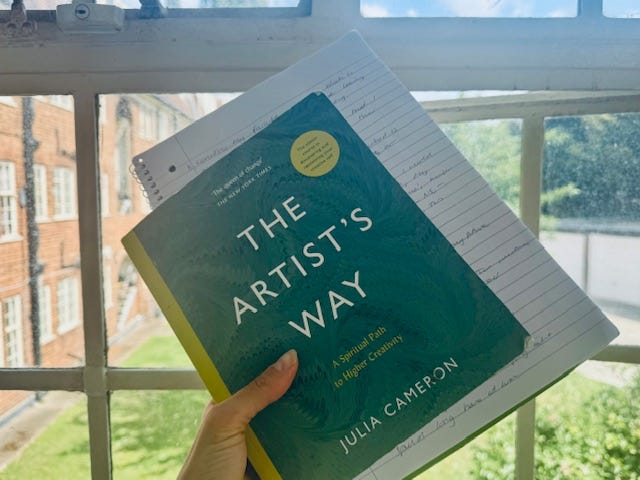Why is everyone doing The Artist’s Way?
The thirty-year-old guide to creative practice is an Amazon bestseller – and I think I know why.
Did you do your morning pages today? If you’ve read The Artist’s Way, you’ll know what I’m talking about. Julia Cameron’s 1992 guide to recovering your creative practice is a cult classic. Elizabeth Day is a fan – as are Michaela Coel, Martin Scorsese and John Cleese.
I say ‘read,’ but really, people don’t read The Artist’s Way. They do it. If you’re not familiar, the book outlines a twelve-week program for ‘blocked creatives’ to rediscover their inner artist. Two things are core to this program: the morning pages, and the artist’s date. The latter is what it sounds like: taking your creative self on a weekly date somewhere inspirational. The former is the piece which some people initially struggle with: three pages of longhand, to be written first thing in the morning.
The morning pages are designed to get your thoughts out of your head and onto the page before your day starts. But they’re more than that, too. Because The Artist’s Way is a spiritual book, albeit spiritual in much the same way that Alcoholics Anonymous is; you don’t have to believe in God to do it, but you should be open to something greater than yourself.
Throughout the book, Cameron invites readers to look for moments of ‘synchronicity’ from this higher power, sharing stories of chance meetings leading to big commissions, or an artist finding the one thing her studio was missing at a yard sale. Do the legwork, Cameron says, and God will put opportunities in your path – sometimes, from the places you least expect.
In a funny bit of meta-synchronicity, I started The Artist’s Way last month – and immediately saw it everywhere. The book keeps popping up on podcasts and in Substacks. One of my close friends kicked off the same week I did. Four weeks in, I took a trip to Wicklow with a therapist friend and showed her my copy. The next day, she texted me: “One of my clients brought up The Artist’s Way!” Clearly, there is something in the air. The 2020 edition is currently the number one art criticism book on Amazon, ahead of John Berger’s Ways of Seeing.
So why have so many of us simultaneously sought guidance from a decades-old book? Partly, I think, it’s for reassurance at a moment which feels both stable and unstable. On the one hand, we’re settled into post-pandemic routines, able to finally catch our breath and start thinking about what comes next. But at the same time, old industries are being rapidly reshaped – especially creative industries such as media and publishing – leaving many questioning if they can remain in the fields they’d planned to spend their whole lives in.
The result is more and more people looking for something new. A survey late last year found a record number of Americans want to switch jobs. Books which question the fixity of our professional identities, too, are having a moment. (I’ve been enjoying Henry Oliver’s Second Act, on what ‘late bloomers,’ from Julia Child to Vera Wang, can teach us about reinvention.) Coaching is on the rise: the International Coaching Federation reported a 54 per cent increase in certified coaches from 2019 to 2022. There is a quiet resurgence in church attendence.
For my part, I started The Artist’s Way because I once wrote every day, until suddenly I didn’t. My friends tried to reassure me it’s not a skill you lose – the standard comparison to riding bikes was made – but in reality, I could feel my edge blunting.
Worse, I had no idea what I’d even want to write about. For five years, I’d started each morning by reading the news and thinking up opinions about it. Now, my mind was refusing to co-operate. On the surface, everything seemed fine: I had a good, interesting job which offered security and enough challenge to keep me occupied. But in private moments, I’d consider the possibility of the writing part of my life being over, and cold fear would flood my body.

I’m pleased – and a little intimidated – to say that, five weeks in to The Artist’s Way, I already have a Google Doc of more ideas than I could ever hope to get through.
When I tell my friends this, there’s excitement. And perhaps this is the real reason so many people are doing The Artist’s Way; one both prosaic and, in its way, beautiful: virality. Over and over again, I’m reminded that the internet is a village and that, as in a real village, everyone sees what everyone else is doing. It’s easy to be cynical about this – is it divine intervention, or did you all just read the same newsletter? – except that I think (and bear with me here) that forming communities to share the things we like is, in itself, close to spiritual.
I know, I know. But while my therapist friend would reference Carl Jung’s ‘collective unconscious,’ and Cameron the will of the creator, you can equally see ‘synchronicity’ as just what happens when you’re willing to put yourself out there and seek connection. In truth, though, I don’t think it matters what you believe; anything which invites creativity is magic. Me, God and Julia Cameron would agree.



